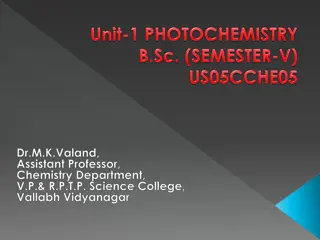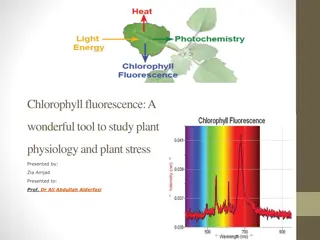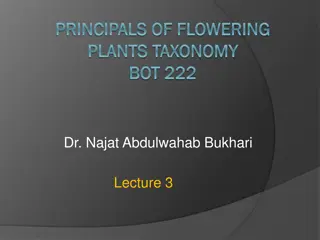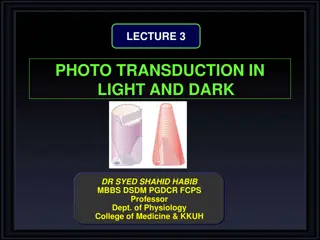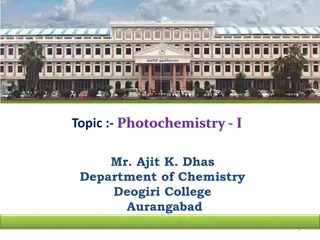
Photochemistry and Photochemical Reactions Overview
Explore the fundamentals of photochemistry and photochemical reactions, including the interaction of light with matter, photo-physical processes, differences between thermal and photochemical reactions, and key principles such as Grothus-Draper Law. Learn about the absorption of light, free energy changes, and the essential role of light in initiating chemical transformations.
Download Presentation

Please find below an Image/Link to download the presentation.
The content on the website is provided AS IS for your information and personal use only. It may not be sold, licensed, or shared on other websites without obtaining consent from the author. If you encounter any issues during the download, it is possible that the publisher has removed the file from their server.
You are allowed to download the files provided on this website for personal or commercial use, subject to the condition that they are used lawfully. All files are the property of their respective owners.
The content on the website is provided AS IS for your information and personal use only. It may not be sold, licensed, or shared on other websites without obtaining consent from the author.
E N D
Presentation Transcript
Dr. S. B Maulage Dept of Chemistry
Photochemistry PHOTOCHEMICAL REACTION: A reaction which takes place by absorption of visible and ultraviolet radiations is called a photochemical reaction and the branch of chemistry which deals with the study of photochemical reactions is called Photochemistry.
Interaction of light with matter: When light falls on matter, then reflection, transmission and absorption may takes place. The Photochemistry is related only with the absorption of light by the matter.
Photo-physical processes: The substance absorb light, emit it without undergoing any chemical changes is termed as photo- physical process. Ex. Fluorescence, Phosphorescence, and photo-electric effects etc. Photochemical changes: In this process, absorption of light brings about some chemical changes in substance. Ex. H2and Cl2reacts explosively in presence of sunlight.
Difference between thermal and photochemical reactions: Thermal Reactions Photochemical reactions In thermal reactions, activation energy is derived due to collisions of reactant molecules. In photochemical reactions, activation energy is derived due to absorption of light by which they are irradiated. In thermal reactions, number of activated molecules depend on temperature of reaction. In photochemical reactions, number of activated molecules depend on intensity of light. The thermal reactions takes place by absorption or evolution of heat. Photochemical reactions involve only absorption of light. Thermal reactions can be carried out in dark also. Photochemical reactions require presence of light.
The free energy change G is always negative in thermal reactions. The free energy change G of most photochemical reactions is negative but it may positive in some cases. Rate of thermal reactions depends on temperature and independent on intensity of light absorbed. Rate depends only on intensity of light absorbed. Ex. i) N2+ 3H2 2NH3 ii) H2+ I2 2HI iii) PCl5 PCl3 + Cl2 Ex. i) 2HBr H2+ Br2 ii) H2+ Cl2 2HCl iii) 2O3 3O2
Photochemical Laws: Grothus-Draper Law: The Gratthus Drapper law is stated as, When light falls on substance only fraction of incident light which is absorbed by the substance can brings about chemical change, reflected and transmitted do not produce any such changes.
Limitations: This law state about absorption of light responsible for the photochemical change but it has following limitations, This law is purely qualitative. It does not give any relationship between amount of light absorbed and number of molecules reacted. It is applicable to primary chemical processes and not for secondary processes.
Stark Einsteins Law: Statement: It is stated as, each molecule taking part in photochemical reaction absorbs one quantum of light energy. From this law it is clear that for a reaction, number of molecules reacted should be equal to number of quanta of light absorbed.
e.g. Polymerization of anthracene into dianthracene takes place in ultra-violet light by absorbing two quanta of light. 2 C14H10 Anthracene C28H20 Dianthracene
The substance undergoing photochemical reaction absorbs equal number of quanta to the number of molecules reacted. The energy of photon or quantum is given as, E = h = h c / Where, frequency of light, - wavelength of light, c velocity of light, h Plank s constant.
Limitations The law of photochemical equivalence is applicable to primary processes where one molecule get reacted by absorption of one quantum energy but it is failed in such reactions where more number of quanta of energy are required for one molecule to react. The law of photochemical equivalence is not applicable in photo-initiated chain reactions. In such reactions by absorption of one quantum of energy large number of molecules get reacted.
Joblonski Diagram: A Jablonski Jablonski diagram the electronic states of a molecule and the transitions between them. diagram is a diagram that illustrates


